This is my review after a couple of thousand kilometres on the new-to-me, but somewhat old, 1998 Ducati SuperSport 900 i.e. (fuel-injected). Sorry I’m a couple of decades late on this motorcycle.
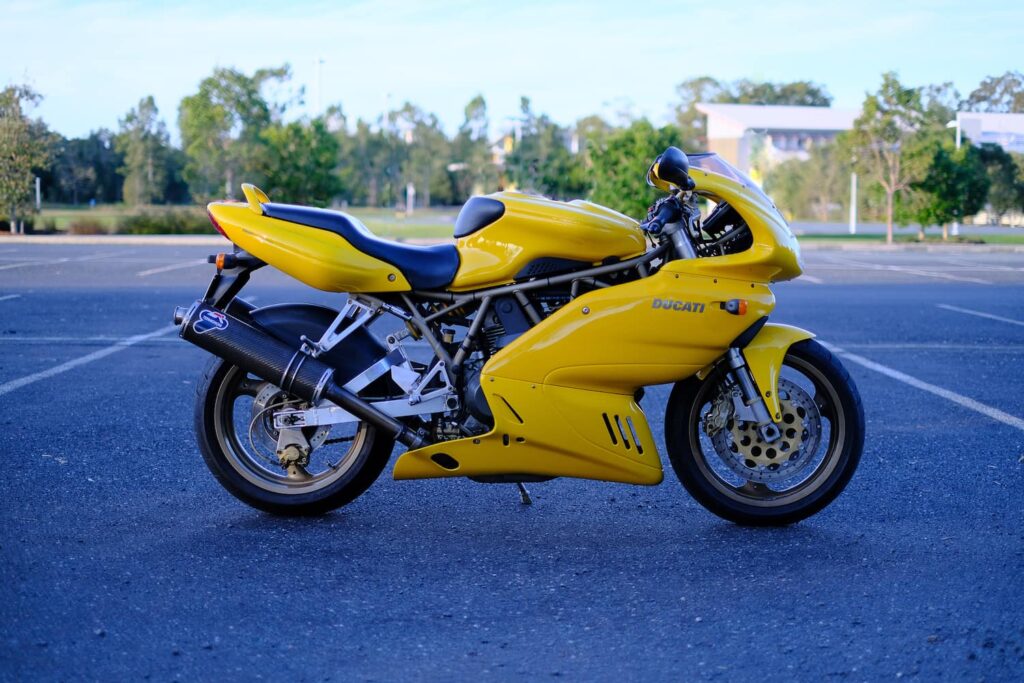
There’s an old article called Song of the Sausage Creature (here’s my archive copy), by Hunter S. Thompson, published in an old edition of Cycle World. It was a review of the carburettor-fed Ducati 900SS, the predecessor to the Ducati 900 SuperSport that I bought.
Hunter S. Thompson was an eccentric writer. I mean, what’s with that title “Song of the Sausage Creature”? What even is a “sausage creature”? Is it a reference to the motorcycle? To its crazy internals? No…
It turns out that the “Sausage Creature” is what you’re reduced to if you crash your motorcycle. Because that’s what he feared, riding the 900SS, in prone position flying along at 90 mph.
I was hunched over the tank like a person diving into a pool that got emptied yesterday. Whacko! Bashed on the concrete bottom, flesh ripped off, a Sausage Creature with no teeth.
So that’s how the 900SS used to feel. Like an impossibly fast sports motorcycle. At least, that’s how famous “gonzo” journalist Hunter Thompson described it. (By the way, “gonzo” journalism sounds like a lot of fun.)
But is the 900SS really a motorbike that can make you into a “sausage creature” today? Times have changed. Motorcycles go a lot faster, and we wear full-face helmets. (By “we”, I mean me. Not necessarily you, my squiddy friend.)
So let me tell you about my Ducati 900 SuperSport. I’ll go through this by addressing the following:
Are you obsessed with motorcycles?
Well, I am. That’s why I created this site — as an outlet. I love learning and sharing what others might find useful. If you like what you read here, and you’re a fraction as obsessed as I am, you might like to know when I’ve published more. (Check the latest for an idea of what you’ll see.)
A bit of background about the Ducati SuperSport 900
OK, firstly, the fuel-injected version isn’t the coolest Ducati SuperSport 900 around. The earlier one is!
There were lots of motorcycles with the name “SuperSport” (or some variant, like “Super Sport”) from Ducati, but let’s start in 1991.
In 1991, Ducati released this thing:
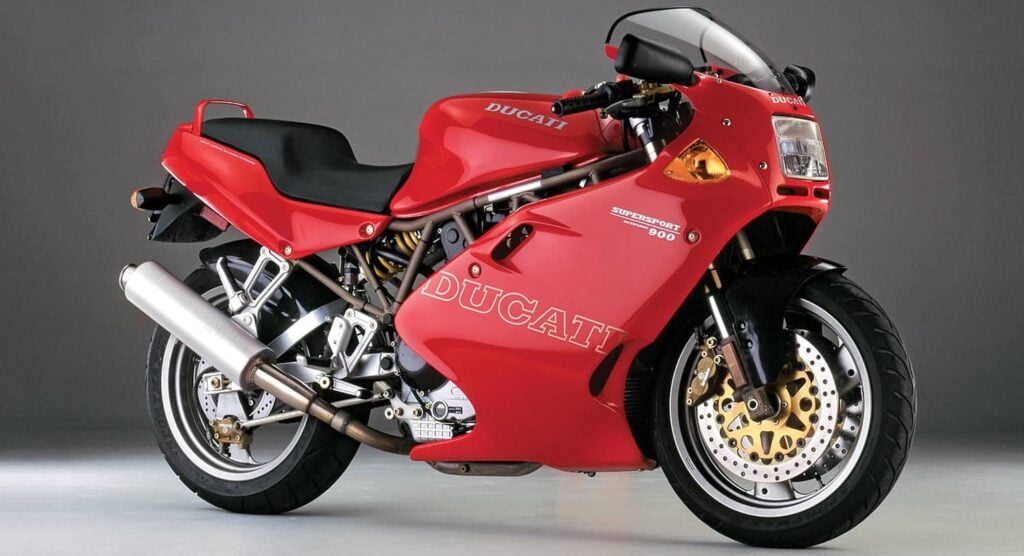
This is the original SuperSport of the modern era.
It pre-dates the Ducati Monster, a much-loved motorbike that was my very first Ducati (and the feeling I was trying to replicate with the SS900).
The first-gen 900SS has a 904cc air-/oil-cooled desmodromic V-twin with two valves per cylinder. It weighs a relatively light 187 kg (414 lb) dry, is fed through twin Mikuni carbs, and is surprisingly comfortable, at least compared to the Ducati 916 superbike of the day.
If you keep hearing the term “desmodromic valves” and are sick of not knowing what it means, here’s my simple explainer on what desmodromic means.
The engine output of the carburettor-fed SuperSport is modest — 62 kW/84 hp. You might think “Wait a second, that’s SV650 territory!” and you’d be right. The 900 SuperSport has a somewhat gentle engine. This is what makes it so different to the 916 of the time.
If you want to really get into details, here are the differences between the 916 and the 900SS:
- The 900SS has a gentle, un-stressed 9.2:1 compression ratio; the 916 has a whopping 11:1 compression ratio (high for the time, modest for now)
- The 900SS is air/oil-cooled; the 916 is liquid-cooled
- The 900SS is fed through carburettors; the 916 is fuel-injected
- The 900SS has two valves-per-cylinder; the 916 has four
- … Sigh, do you want more? They as just different bikes.
They 900SS and 916 do keep in common being large-displacement Desmo V-twins, and having a dry clutch for that clackety-clack that Ducati fans can’t get enough of.
The 900 SuperSport of the time came in a few versions — half-faired versions were and remain more popular. On the used market, the solo-seat Superlight models are more popular still. A well-kept Superlight (or SL) will cost you around twice as much as an equivalent 900SS.
People loved the damn thing, no matter what version it came in. Here’s the opening paragraph from Hunter S. Thompson’s piece in Cycle World:
Some people will tell you that slow is good — and it may be, on some days — but I am here to tell you that fast is better. I’ve always believed this, in spite of the trouble it’s caused me. Being shot out of a cannon will always be better than being squeezed out of a tube. — Hunter S. Thompson, “Song of the Sausage Creature
His quotes are almost as applicable to the fuel-injected SS900 as they were to the carburettor-fed version. So I’ll pepper this article with them.
Ducati released the second, fuel-injected version of the 900SS in mid-1998. It has the same basic motor, but now spark and fuel are controlled by a Marelli ECU. Power is down to 60 kW / 80 bhp, but still in the same ballpark.
More importantly, Ducati totally changed the aesthetics of the motorbike totally in mid 1998. Gone are the straight lines of the early nineties 900SS; the mid-1998 (and onward) 900SS is curvy and rounded.
Compare the above photo of a red 900SS with a red one from a later year, for a more direct comparison.
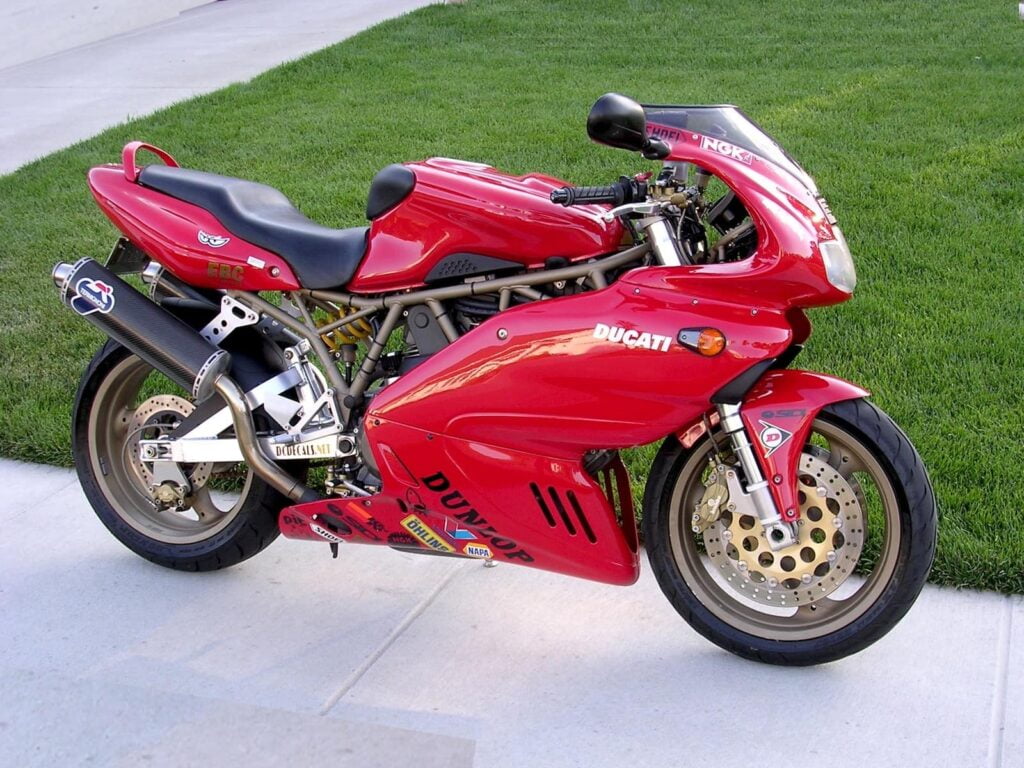
My bike is so much faster than yours that I dare you to ride it, you lame little turd. Do you have the balls to ride this BOTTOMLESS PIT OF TORQUE? — Hunter S. Thompson, “Song of the Sausage Creature
The above example has a few stickers on it (probably to hide blemishes), but apart from that, you can see how the curves are so different to the more oblong shape of the original 900SS.
Most people weren’t fans of the new design. It actually took a while to find a good photo. But I really like the shape of the curvy 900SS, especially in the yellow I have… perhaps, like many of Ducati’s designs, it was just too far ahead of its time and it aged well.
The design of the headlight hasn’t aged as well. But whatever! I can’t see that from most angles…
So what’s the Ducati SuperSport 900 like to ride?
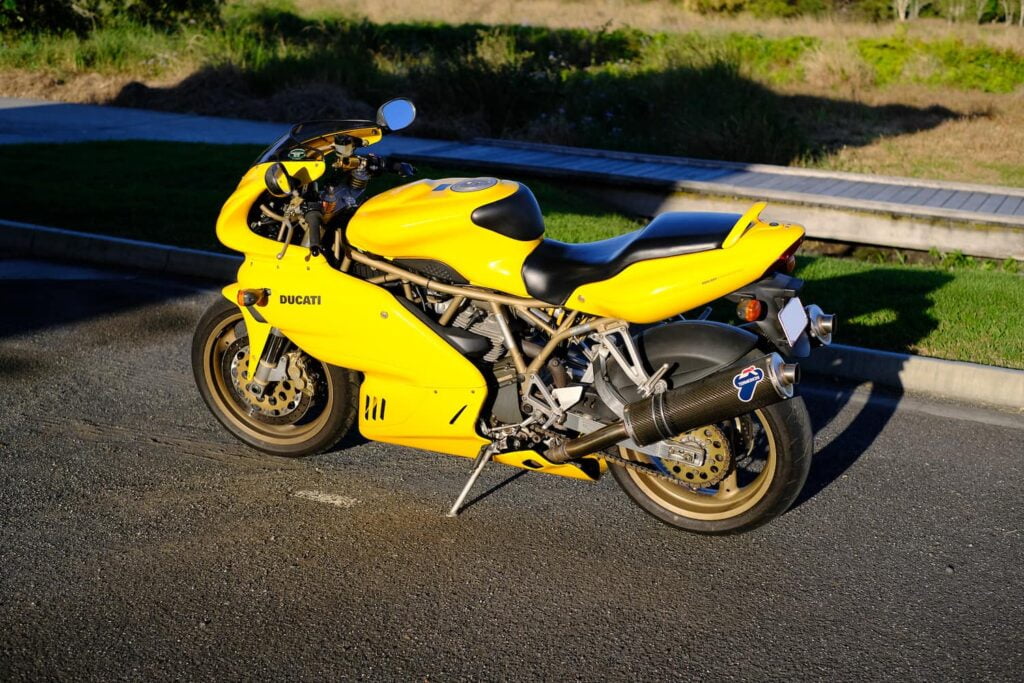
The fuel-injected 900SS is like an old Ducati: it’s cantankerous, it’s loud, and it’s decent fun.
I thought that the SuperSport 900 would be like a Monster 900 with clip-ons. It is… but it also highlights why that’s not a very good idea. If you’re going to hunch forwards, there should be no point in time when you think the word “anaemic” is a good description. Which it sometimes is.
I also thought the SuperSport 900 would be like a Suzuki SV650 but with more character. It is… in that it provides around the same mid-range. But it still lurches down low — having less power doesn’t mean having better low-speed manners. And a bike this thundering is also an example of why a bike with utilitarian power maybe shouldn’t have too much character.
The first time I powered up the 900SS I said YES! THAT IS IT! That’s the sound a Ducati should make. It absolutely bellowed through the Termignoni exhausts (which didn’t have baffles… and maybe never had baffles) and shook through the whole parking lot where I was doing the deal.
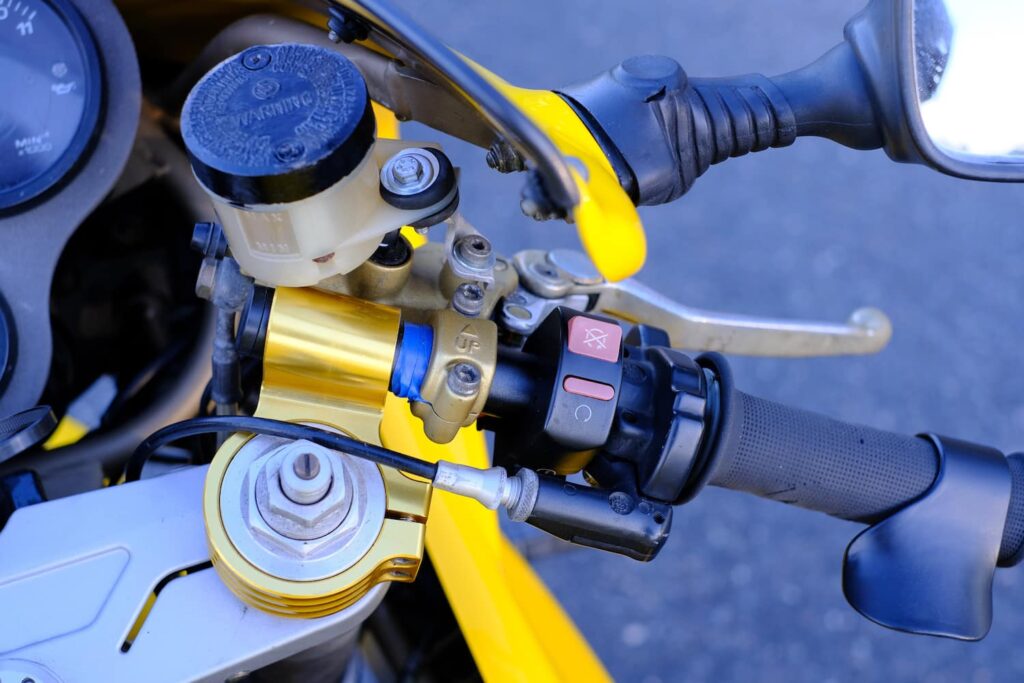
I paid the man his money and got going.
The first thing I noticed was that while the exhaust noise was loud, what I heard from the perspective of a rider was intake noise. It was sucking so much air through the intake that I thought it must be an open box with cone filters or something. It wasn’t — just a regular filter with the plastic box intact.
Second thing was that… this thing didn’t handle too well.
I’m not sure what I was expecting. I’m not terribly sure what it means for a bike to handle on “rails” or to be easy to push through corners. I did ride a superbike normally (a 1098S), but I wouldn’t call it “easy” to handle in everyday situations.
If you’ve ever ridden a 600cc supersport bike, you probably know that the clip-ons are quite narrow. This means that to go right or left, you have to push a little harder than you would than if you had wide handlebars. The bikes usually make up for this by being lightweight, though — under 190 kg and sometimes under 180 kg wet weight. Every 10kg counts.
But the 900SS is a fairly heavy bike at over 200 kg fully fuelled, and it still has narrow clip-ons. This means that to push it through a corner, you have to be quite deliberate.
It doesn’t just dance into corners or hold a line steadily like other Ducati motorbikes with more advanced suspension, either. It might be that these are cheaper motorbikes and your average owner doesn’t change the fork oil every so often like they’re supposed to (guilty). But it just adds up to a bike that doesn’t feel as confident cornering as more modern, or more premium machines.
I do bear responsibility for the above. The suspension setup is the responsibility of the owner. I’m just trying to tell you though that if you go buy a SuperSport 900 because it’s cheap and you intend to have fun on it, you’ll probably have to invest some time and/or money into getting it feeling like it’s really meant to. If you do, I’ve heard that people can love the way these handle — I never got it to that point.
Finally, 80 hp or even fewer kilowatts doesn’t feel like much these days, particularly as it isn’t from the very bottom, and the motorcycle isn’t that light.
On lighter and/or more powerful motorbikes, it’s easy to power out of corners by just twisting the throttle a bit.
Having less power (and less braking ability, by the way) means you have to be a lot more thoughtful in your cornering. This can make you a better rider, sure; but it’s also just less fun. Depends on what your priorities are. Personally, I didn’t enjoy it. Sometimes I want to learn, like maybe at the track, but usually I ride for the feeling of fun I want it to leave me.
But there is also Fun, the deadly element, and Fun is what you get when you screw this monster on. BOOM! Instant take-off, no screeching or squawking around like a fool with your teeth clamping down on our tongue and your mind completely empty of everything but fear. — Hunter S. Thompson, “Song of the Sausage Creature
(I’m glad he had fun!)
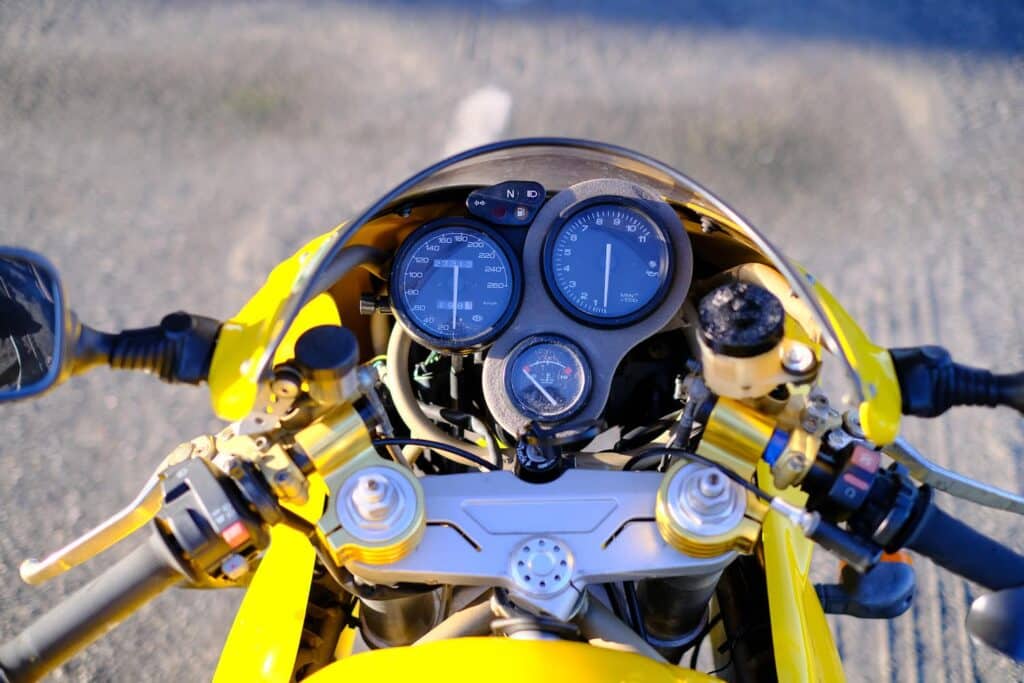
Servicing the Ducati Supersport 900
OK, one thing that’s amazing about the SS900 is that it’s a total doddle to service.
Servicing many sport bikes is annoying and involves removing fairings. Not so on the SS900! You can get to all the relays either just by raising the seat (opened with a key) or by opening the relay box in front of you. And you can get to the air filter by lifting up the tank, which is about 30 seconds more effort than raising the seat. Modern bikes have the tank bolted down; older bikes like the SS900 have a hinged rear and a rubber thingy holding it down at the front.
Adjusting the chain means you have to have a big wrench, but you don’t need as big a torque wrench as you do on a single-sided swingarm bike, as you have two bolts. Of course, a slight disadvantage of the standard double-sided swing-arm bikes is that you need to ensure your wheel remains aligned by adjusting both sides the same amount.
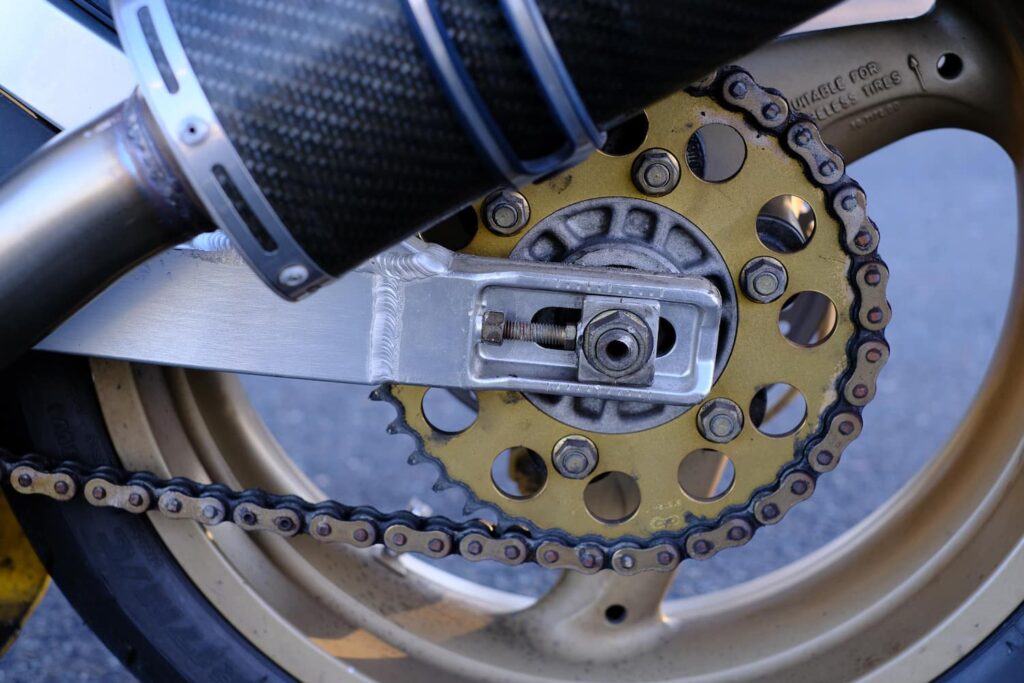
Of course, changing the spark plugs or checking the valves on a V-twin Ducati is a royal pain in the arse. You’ll have to take off plastics, remove the battery, remove the air filter box, and do a bit of jujitsu just to measure the valve gap in the top cylinder; let alone replace the shims.
The usual things can go wrong with the 900SS that can go wrong with any Ducati fuel-injected bike. These include:
- The regulator/rectifier might fail. Check the battery often to make sure it’s holding charge. This just happens with time, it’s not a Ducati thing.
- The crank angle position sensor might get dirty/fail — make sure it is cleaned at every service
- The oil pressure sensor might fail, triggering the light even if your oil level is fine (and causing a gentle leak)
- Various bolts can shake themselves loose. Did you know that Ducatis vibrate a lot?
- Fuses might blow — carry spares! (and do try to figure out why the fuses blew)
- Wiring might get pinched (and break), hoses might get pinched (and prevent flow), especially when lifting the tank or removing/replacing fairing pieces
It’s basically a live animal, and you have to treat it as such, checking everything constantly.
What to look for when buying a used Ducati 900SS Supersport
If you want a bigger answer, check my general article on what to check when buying a used Ducati.
In general, make sure the valve service was done and that the belts have been replaced. How often should belts be replaced? Every five years or 10,000 km for this vintage of Ducati motorbikes, using modern belts. Every two years is a little extreme — that was set in times when belts were just of lower quality. Talk to any Ducati mechanic and they’ll say five years is the new standard.
For Supersports in particular, because they’re of this age, focus on
- Tank intact — it’ll be hard to find an intact tank. It’s OK if it needs a bit of paint. But if it’s dented, you’ll find it impossible to repair without a full disassembly — it’s angular, hard to get repair tools into, and made of thick-ish metal. If the guy selling it says “You just need a dent puller bro” then you can be sure it needs more than that. (“Bro” is the giveaway. Don’t call me “bro”!)
- Fairings intact — go up close and you’re likely to find all kinds of weird things with the fairings like missing bolts, clips, or glued bits. My fairing was like this. It’s hard (impossible) to find a new fairing kit, and you’ll definitely have to get the tank painted to match, so you want to avoid this unless you’re looking to do a full restoration.
- Leaky head — early air-cooled Ducatis often had gentle oil weeps from the head (which doesn’t have a gasket), often from around the bolts. It’s good preventative maintenance to replace the bolts before they rust out and snap when you try to undo them. But be prepared to have to deal with a snapped bolt when you try to do this maintenance… otherwise, maybe don’t fix it if it ain’t broke.
Aside from that, since it’s an old bike, go through the usual checklist when buying a used motorcycle.

I’d pay particular attention to difficult-to-replace things that happen on old bikes, like
- Worn bearings in the steering head and wheels
- Bent frame bits (someone may have crashed it uninsured and not written it off) — look at all the controls for scrapes (or replacement)
- Old tyres (check out the tire date codes — see my guide to reading them in five seconds)
Final words
I eventually sold the 900SS. I decided to be a one-bike guy, and it couldn’t be this — not reliable enough, too loud, and also, just not hooligan enough. A little too sedate. Less than 100 hp these days to me feels boring.
But I still thought it was really nice to look at.
A fool couldn’t ride the Vincent Black Shadow more than once, but a fool can ride a Ducati 900 many times, and it will always be a bloodcurdling kind of fun. That is the Curse of Speed which has plagued me all my life. I am a slave to it. On my tombstone they will carve, “IT NEVER GOT FAST ENOUGH FOR ME.” — Hunter S. Thompson, “Song of the Sausage Creature
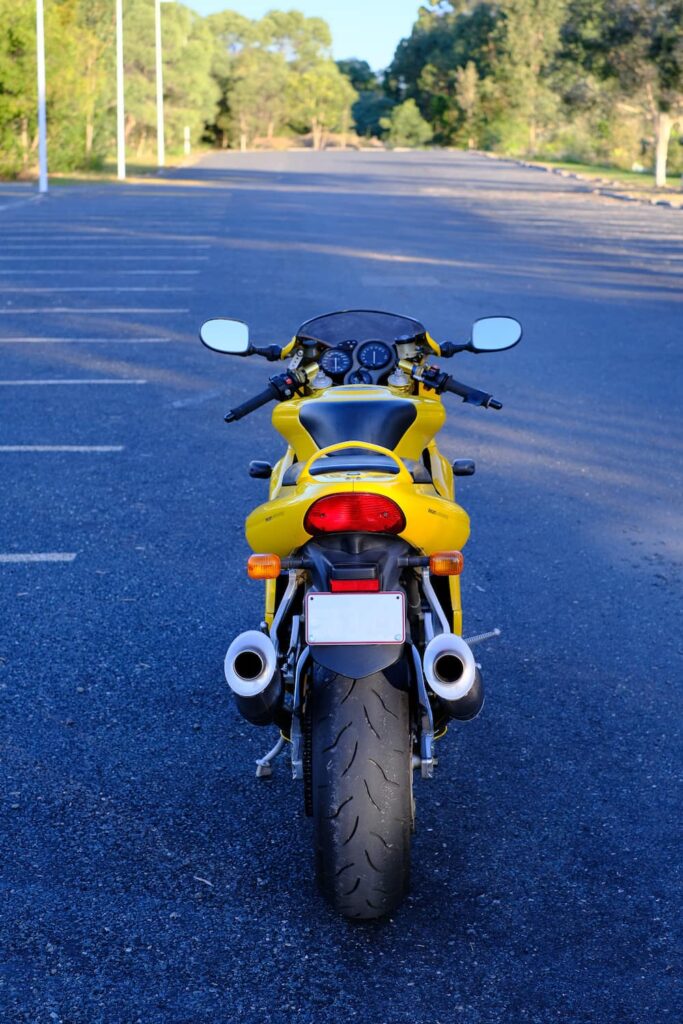

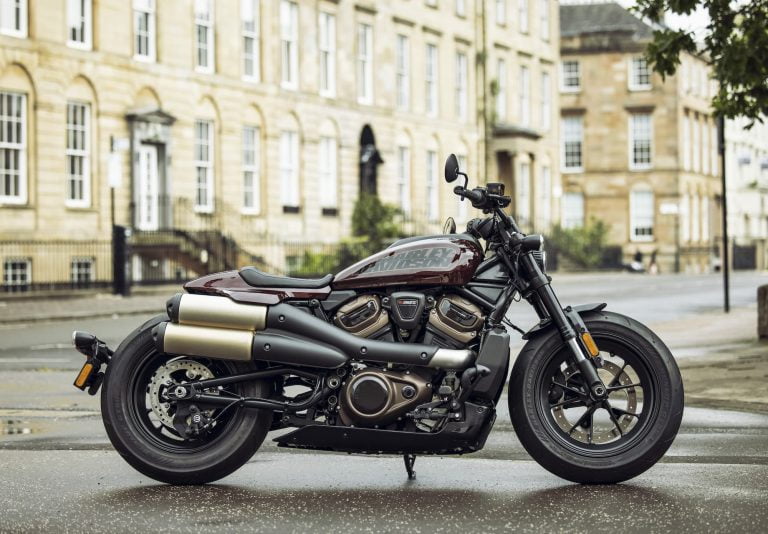
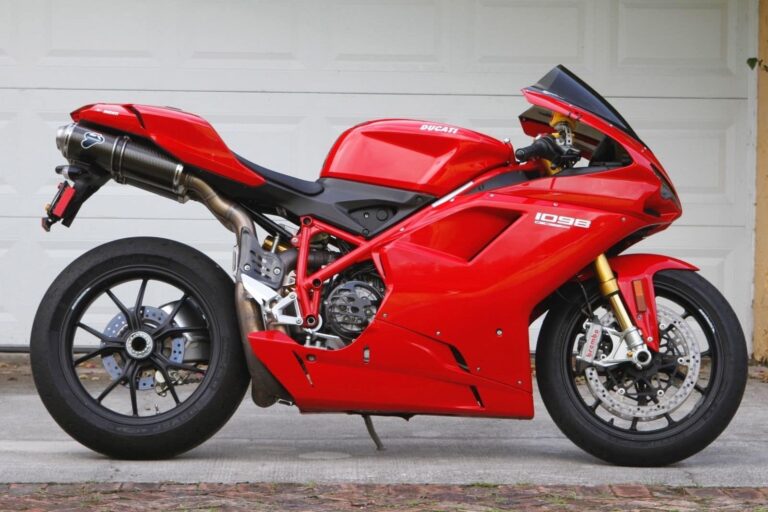
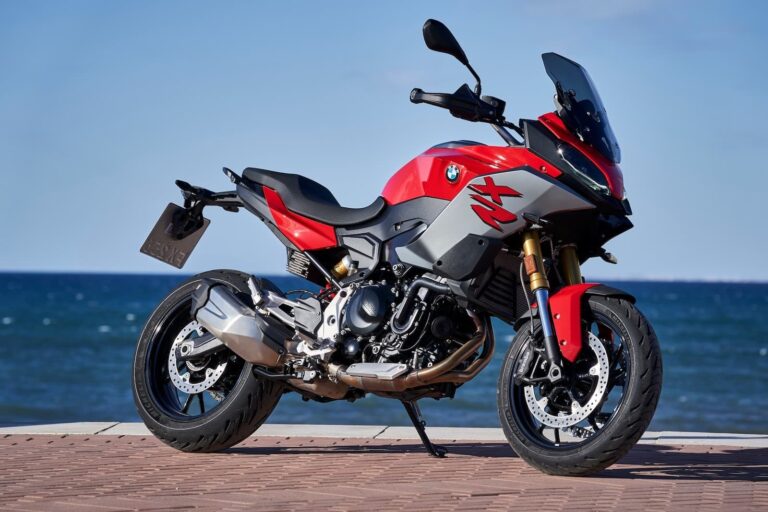
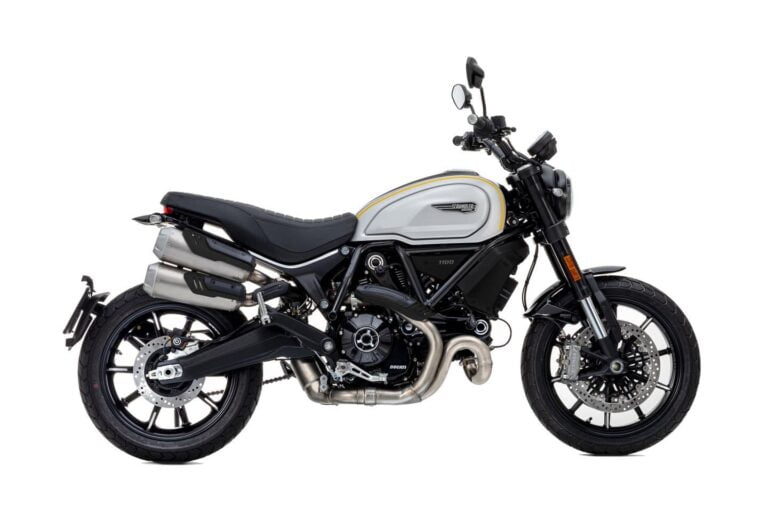
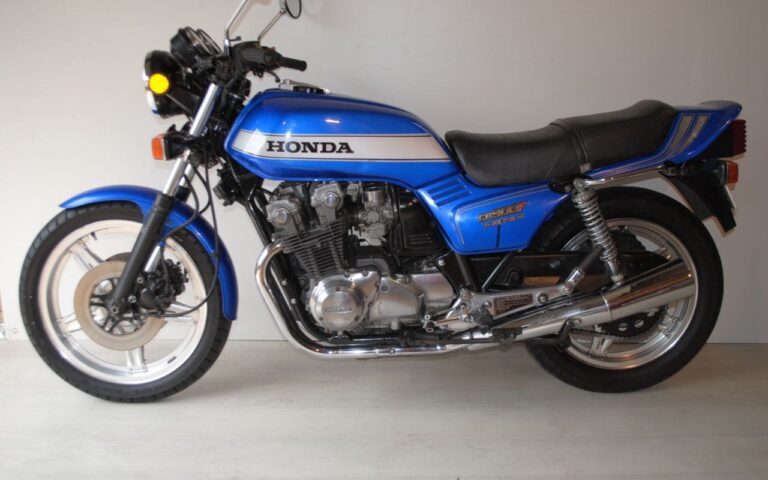
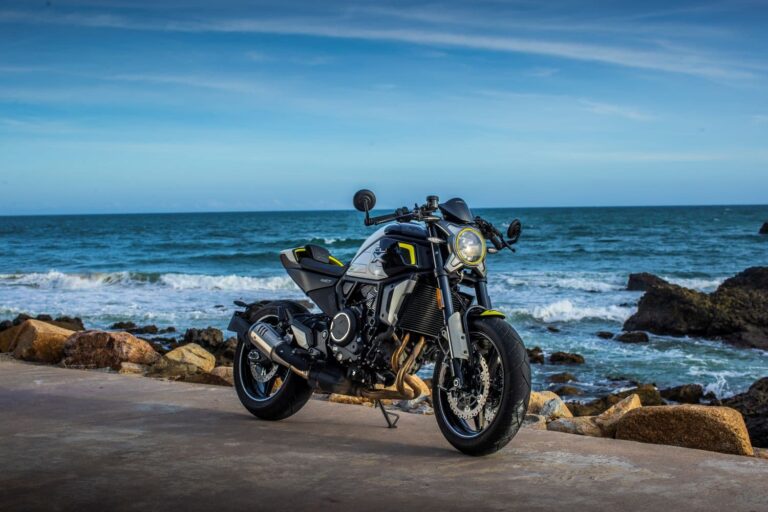
Hi! Some comments… I have a ’98 – the first year of this model. I also have a new ’21 Ducati Supersport S and have owned several bikes, like CBR 600s and such.
The slow steering on the 900 is mostly fixed by fitting the right tires. I changed to Michelins and it made the bike steer much lighter.
I think You had a bike that really needed some understanding and attention. Loose nuts? Mine has run 74000 km. and the only loose bolt ever was the big axle nut on the rear wheel. Fixed with Locktite. Otherwise the bike has had front wheel bearings changed (from pressurized washing) and now the relay to the starter is gone. That’s all for 74000 km’s….. It’s a well built, reliable bike and so says the largest workshop here in Norway. Weak or bad brakes? They are excellent and the same as used on the 916/748/996 back then. Heavy? It is only 184 kgs dry…. Low power? Yes it’s not very strong but a Ducati is ridden in the midrange between 4000 and 7-8000 rpm. Even this bike can be quick on the smaller roads. More focus on finding the right lines and less on gear changes. With the most glorious sound of any bike….mine has open mufflers too ❤ And this older one it is still the bike i love to ride the most – for that genuine motorcycle feel.